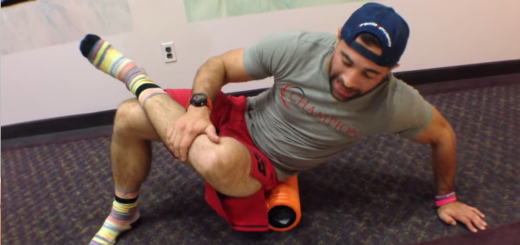Motivation & Athlete Self-Talk
“Whether you think you can or you can’t, you’re right” ~ Henry Ford
Mobilize Your Mind: Athlete Self Talk
 [2]
[2]
It is a known fact that we talk to ourselves all the time – sometimes inside our heads, and sometimes out loud. For those of us CrossFitters, this means we are also, inevitably, talking to ourselves in a certain way in the time leading up to a workout, during the workout itself, and afterward. What if we consciously tried to prep and train our ways of thinking in order to improve performance? In the same way that we work on perfecting our physical movements and techniques, we can develop positive habits of our mental performance.
Anyone who has ever completed a tough WOD knows that more often than not, the greatest obstacle to finishing is not our bodies, but our minds. In Part 1 of this 3-part series, find out how to define athlete self-talk and “mobilize” your mind before a workout.
What Is Athlete Self-Talk?
The answer is exactly what one might expect: the way athletes talk to themselves – before, during, and after any athletic performance – is considered athlete self talk[3]. Sometimes thoughts come in the form of mental imagery or concepts, but it is there regardless of an athlete’s level of awareness about it.
As one tennis article[4] explains, “if we opened up a person’s head, we would see a popcorn machine full of thoughts and emotions endlessly popping, perculating (sic) and colliding.”
It is the “colliding” aspect of self-talk that can often inhibit performance, especially when negative thoughts or feelings become part of an athlete’s internal dialogue.
During a workout or other athletic performance, these negative thoughts are likely to enter our minds as our bodies start to feel fatigue. Thus, athletes have to prepare to battle actively against those negative thoughts before the workout even begins. In the brief one-minute commercial[5] below, James Hobart of CrossFit New England[6] demonstrates how he responds to every negative thought with a positive rebuttal.
Being Your Own Coach
1. Establish a Positive Mental Framework
Ben Bergeron, who coached the CrossFit New England team all the way to the CrossFit Games Affiliate Cup Championship in 2011, emphasizes this unique mantra: “Think like a bumblebee; train like a racehorse.” He explains[7] this way of thinking for his athletes:
- Bumblebees, from a physics perspective, should not be able to fly: You, as an athlete, need to have unyielding belief in yourself. Don’t let your past, your peers, your family or your competitors limit your performance.
- Racehorses do what is asked of them: Racehorses don’t look at other horses’ training programs and freak out because the other horses are doing double days. Racehorses just do exactly what is asked of them—nothing more, nothing less. Racehorses have 100 percent commitment to their program, to their coaches and to being the best they can be.
A good, general way to prepare before a workout is to ask yourself the following three questions, as suggested by Dawn Fletcher[8], a CrossFitter and expert in sport psychology:
- Why am I here today?
- What do I hope to accomplish?
- How will I make this an enjoyable experience?
While the answers to these questions will vary on a daily and maybe even hourly basis, having a clear purpose in mind about the “why” of a training session will lead to greater focus during the workout itself.
2. Understand Your Focus Style
Picture yourself at the box. Do you have to get quiet and centered before the clock starts? Or can you laugh and joke all the way up until you’re standing in front of the bar? Part of mental prep is also knowing your individual focus style[9].
Internal focus style Athletes with an internal focus style perform best when they’re totally and consistently focused on their sport during a practice session or a competition They need to keep their focus narrow, thinking only about their sport. If they broaden their focus, for example, if they talk about non-sport topics during warm-up, they’ll become distracted and will have trouble refocusing and performance will suffer.
External focus style. Athletes with an external focus style perform best when they only focus on their sport when they’re about to begin a competition. At all other times, it is best for them to broaden their focus and take their mind off their sport. These athletes have a tendency to think too much, become negative and critical, and experience workout anxiety. For these athletes, it’s essential that they take their focus away from their sport when they’re not actually performing.
Many coaches think that if athletes are not totally focused on their sport, then they’re not serious about it and they won’t perform their best. Yet, for athletes with an external focus style, they don’t want to think too much or be too serious because this causes them to lose confidence and become anxious.
Consider which of these most closely describes you in order to manage your thoughts accordingly prior to performance or competition. [10]
[10]
3. Eliminate the “bad” thoughts
Many experienced CrossFitters develop strategies for managing tough workouts: “I’m going to do sets of 5 reps at a time” or “I’m going to take mini-rests approximately every two minutes.” It’s both calming and reasonable to do this kind of planning to avoid a physical burnout. Similarly, we can make plans for managing our athlete self-talk for the same reason: to prevent a mental burnout.
Aaron Weintraub, a college baseball coach and performance consultant, offers the following advice[11]:
Because the mind communicates with the body…all thoughts by athletes about what not to do should be reframed or countered into positive statements before the performance is attempted. Change “don’t walk this guy” into “throw strikes.” Change “don’t press” into “stay within yourself.” Change “I can’t finish my workout” into “I can finish my workout.”
Immediately before you perform, your self-talk should be positive and functional, keeping it simple so that you may focus wholly on the task-at-hand.
He also offers the following list of words/phrases to avoid[12]:
- Can’t
- I’m not…
- Need/Have to
- Should/supposed to
- Fail/failure
- Always/Never
- I stink/suck (and other variations)
- Hate
- That’s not fair.
- That’s discouraging.
Any of those sound like thoughts that have run through your head? Similarly, the Elizabethtown Aquatic Club[13] (EAC) provides another helpful list – areas of focus to avoid[14]:
- the past or the future – stay in control of each moment as it comes
- weaknesses, especially during a performance or competition
- fixating on the outcome instead of the process
- uncontrollable factors (i.e. weather, other athletes)
- demanding perfection
4. Make a Positive Self-Talk Plan
The first step to creating change is to become aware of your existing self-talk. Pay attention to the words, thoughts, and images running through your mind before, during, and after a workout for a few days, and write them down, just as you track your performance times or reps for a WOD. Actively listen to yourself and take note of any negative language or focus areas.
The harder part that follows is changing the negative self-talk into positive self-talk. Golfers, a group of athletes who are impacted deeply by poor mental prep, put in tremendous effort to train mentally[16]:
- [Golfers’] mental training includes changing negative thoughts into saying “I can”, “I will”, “I can recover”, “thank you”. They avoid the failure statements of “I can’t”, “if only”, “I could have”, “I hope”, “It’s a hard shot”, “It’s a tough hole”. They repeat the positive messages until they are wired into their brains, body and spirit and have become a conditioned response.
- Don’t agree mentally when someone makes a negative statement. Breathe to relax your mind. Ignore the comment or turn it around and tell yourself the opposite positive message inside your head.
- Program your self-talk towards what you want instead of away from what you don’t want. If you tell yourself not to miss another shot, your subconscious mind will reinforce the missed shot. What you resist, persists. This is called negative hypnotic programming. Focus your dominant thought on what you do want.
Examine your self-talk notes, and next to every negative thought, phrase, or image, plant a positive replacement word, phrase, or image. It sounds too simple to be effective, but it is necessary in order to combat negative thoughts that may creep in during a workout. The EAC explains[17] it this way: “Imagine that the mind is like a cup–if it is filled to the top with positive thoughts, there will be no room for negative self-talk. Athletes need to identify positive self-talk in advance and replace the negative thoughts with identified positive ones.”
It’s Up to You
It is very likely that you as a CrossFit athlete spend ample time focusing on improving different skills and movements. You probably also think about how to eat well and rest adequately in order to improve. Consider, then, what new levels of elite fitness you might reach if you put similar effort into training your brain to become your best ally.
- Tell yourself what you CAN do.
- Plant positives.
- Develop a Self-Talk Plan…and practice it, just like physical training.
Resolve to get your mental game on. 3…2…1… GO.
Original Article by: Kristy Parrish at TabataTimes





